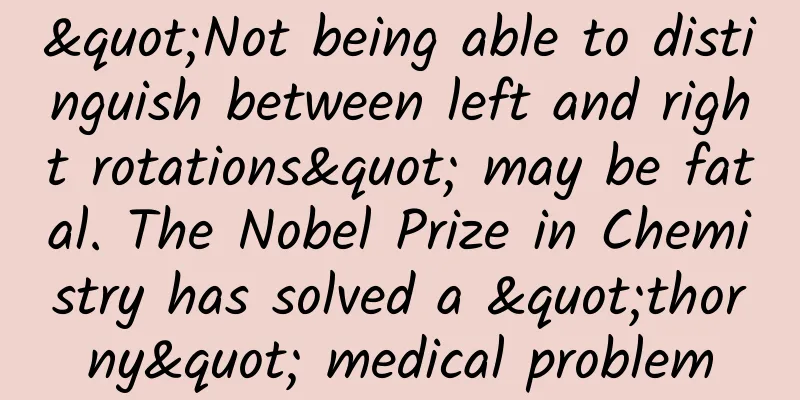"Not being able to distinguish between left and right rotations" may be fatal. The Nobel Prize in Chemistry has solved a "thorny" medical problem

|
In the early 1960s, a notorious drug safety incident, the "Thalidomide" scandal, broke out in 46 countries around the world. As "the largest man-made medical disaster in history", this accident caused more than 10,000 children to be born with severely deformed legs like seals, and tens of thousands of pregnant women to have miscarriages. The culprit of this disaster was a drug with a "mirror molecule" - thalidomide. Because of people's ignorance of left-handed and right-handed compounds, many innocent children paid a heavy price. ▲Deformed seal babies born due to the thalidomide scandal (Source: Wikipedia) The products of some chemical reactions contain two "chiral" products. From the perspective of molecular structure, the two products are mirror images of each other, just like the left hand and the right hand, or ourselves and ourselves in the mirror. However, although they look similar, chiral molecules may have completely different functions. ▲Two mirror images of limonene molecules, one smells like lemons and the other smells like oranges Sometimes, two chiral molecules just smell different. Sometimes, they differ in how effective they are as products. But other times, one is a drug that chemists want to make, while the other is a poison that people avoid, as we saw in the case of thalidomide. To avoid similar disasters, chemists can use "asymmetric catalysis" to make the product of a chemical reaction more common than the other of the two possible chiral molecules. But such catalytic reactions have been difficult to achieve in the past century. The discovery of "asymmetric organocatalysis," which has just been awarded the 2021 Nobel Prize in Chemistry, has taken the process of making molecules to a whole new level. Not only has it made chemistry more environmentally friendly, it has also made it easier to produce asymmetric molecules. Today, researchers can relatively easily make a large number of different asymmetric molecules, including those with potential therapeutic effects. ▲The Nobel Prize in Chemistry, which is jokingly called the "Science Prize", finally became "serious" this year, returning the chemistry prize to the "old profession" of chemistry. German chemist Benjamin List and American chemist David MacMillan were awarded the 2021 Nobel Prize in Chemistry for their outstanding contributions in the field of "asymmetric organic catalysis". (Image source: Nobel Prize official website) Catalysts: The diamond in the hands of chemists If we imagine our world as made up of building blocks, then chemists are undoubtedly the most creative people: they combine different chemical elements like building blocks to create a variety of shapes. Some of the "creative ideas" of chemists may have never been seen before in nature. They can use these building blocks to "build" new materials that can benefit mankind, making them have excellent properties such as "more durable" and "more elastic". However, the process of building new molecules requires not only wild ideas, but also overcoming some engineering difficulties. As the Nobel Prize official said, "Every new tool that chemists add to the toolbox improves the precision of molecular structure. Slowly but surely, chemistry has evolved from a 'Stone Age' discipline to a 'finely crafted' discipline." Especially as the industrial level of human society continues to develop, chemists' ambitions are no longer as simple as putting together a new "building block" - is there any way to improve production efficiency and bring more possibilities? ▲Without the right tools, even the best craftsmen can only stay in the "Stone Age" (Image source: Nobel Prize official website) We learned in chemistry class that although catalysts do not become part of the final product, they can reduce the conditions required for the original reaction and change the chemical reaction rate of the reactants by interacting with the reaction substrates. For a long time, people thought that there were only two types of catalysts available: enzymes or metals. However, at the turn of the century, two Nobel laureates independently discovered a third type of catalyst, giving chemists a long-desired new tool. The third possibility: learning from catalyst "predecessors" All living organisms contain thousands of different enzymes that efficiently drive the chemical reactions necessary for life on a series of "production lines." So some scientists are ready to "borrow tools" from nature. In the 1990s, Benjamin Lister was a postdoctoral fellow in a scientific team at the Scripps Research Institute in the United States, led by the late Carlos F. Barbas III, who was trying to develop new enzyme variants. During his research, Lister began to wonder how enzymes in nature work - they are usually huge protein molecules made up of hundreds of amino acids. In addition to these amino acids, many enzymes also contain metals to help drive the chemical process. Lister thought that enzymes in organisms often have complex components such as "regulatory units", and the catalytic reactions of many enzymes are actually driven by only one or several amino acids in the enzyme. To test his silly idea, Lister tested whether proline could catalyze an aldol reaction, in which carbon atoms from two different molecules join together. To his surprise, proline worked as a catalyst. ▲When he learned that he had won the Nobel Prize, Lister, who was on vacation with his family, felt another "surprise" Metals are another good catalyst because some metal elements can temporarily hold electrons or temporarily donate electrons during chemical processes. These electron "loans" help loosen strong chemical bonds in molecules so that new chemical bonds can form. But some metal catalysts are very sensitive to oxygen and water. It is relatively simple to achieve oxygen-free and moisture-free conditions in the laboratory, but similar conditions are difficult to achieve in large-scale industries. David MacMillan, who originally studied metal catalysts, began to design simple organic catalysts after going to the University of California, Berkeley. Although they are organic, they can temporarily donate or accommodate electrons like metals. After actual testing, the organic molecules designed by McMillan were found to be very effective in driving reactions, just as he had envisioned. The discovery of the two researchers has given chemists new opportunities for creation. Dr. HN Cheng, president of the American Chemical Society, said in an interview with the media that the achievements made by Benjamin List and David MacMillan in the field of organic catalysis are like the development of a "new magic wand." ▲ MacMillan was also the first person to propose the concept of "organocatalysis" (Image source: Princeton University) Johan Åqvist, chairman of the Nobel Prize in Chemistry Committee, commented that the ideas proposed by this year's two winners made people sigh that "this catalytic concept is so simple and ingenious that many people wondered: 'Why didn't we think of it earlier?'" New catalyst "outperforms the original" Compared with enzymes and metals, the two catalyst "predecessors", organic catalysts have outstanding advantages: clean, environmentally friendly, economical and efficient. Compared with some metal catalysts, organic catalysts have a stable carbon framework and are generally "insensitive" to water and oxygen, so their technical difficulty is relatively low whether in storage or use. At the same time, organic catalysts such as proline can be separated and made from natural raw materials in large quantities, with low separation difficulty, low cost of derivative applications, and low cost of production. "Standard catalysts are often metals, but they often have very negative impacts on the environment," said Zheng Huainan. "Metal elements can leak into the environment and accumulate in the food chain, which can cause health and environmental risks." In contrast, organic catalysts are more easily degradable and easy to manufacture, making them "environmentally friendly". On the other hand, although enzymes in nature can catalyze chemical reactions very efficiently and accurately and produce a variety of complex biological macromolecules, they are themselves very complex molecules that are not easy to produce in the laboratory, let alone industrial production. Enzymes in nature have many advantages: they can be precisely regulated, orderly cooperate in multi-step reactions, and produce a variety of complex molecular structures; they need to catalyze reactions at room temperature and pressure, and at lower substrate (reaction "raw material") concentrations. However, these advantages may not be important to chemists. ▲Lister realized that catalyzing chemical reactions does not require complete enzyme molecules (Source: Sina Technology) The discovery of Lister and MacMillan finally brought decades of early exploration to fruition. According to the official evaluation of the Nobel Prize, the development of organic catalysis since 2000 can almost be compared to a "gold rush", and the two pioneers have maintained a leading position in this field. They have designed a large number of cheap and stable organic catalysts that can be used to drive a wide variety of chemical reactions. “Some of these [organic catalysts] do things that enzymes can’t even do,” Lister said. “That’s shocking to me.” Safer and more efficient pharmaceutical manufacturing In addition to being more environmentally friendly than metals and more economical than enzymes, the key to the rapid and large-scale application and development of organic catalysts lies in their outstanding ability to promote "asymmetric catalytic reactions". Thalidomide, whose mirror image molecule can cause "seal limb" deformity in infants, was originally a byproduct discovered by Wilhelm Kunz, a chemist who was a pharmacist, when he was synthesizing antibiotics. Kunz discovered that this compound can not only calm and hypnotize, but also effectively inhibit pregnancy reactions in pregnant women. So in 1957, the West German company Grünenthal renamed thalidomide "Thalidomide". This "ideal choice for pregnant women" was then officially launched on the market and quickly became popular in Europe, Africa, Latin America and other regions. However, with the in-depth study of thalidomide, people discovered that thalidomide is actually a chiral molecule. It is composed of two compounds that are mirror-symmetrical like the "left and right hands". The right-handed compound can inhibit pregnancy and have a sedative and sleeping effect, while its mirror image - the left-handed compound can cause deformities and lead to a large number of "seal babies". Compounds that look so similar and are just mirror images of each other have such different functions in the body. Because of this, many drugs on the market are single-handed drugs (for example, labeled "left-handed" or "right-handed"). ▲Some isomers of chiral drugs can cause adverse reactions (Source: Reference [1]) Before the advent of organic catalytic tools, the traditional methods of producing chiral molecules in the pharmaceutical industry were often very inefficient. For example, people would first prepare a mixture of two mirror images, and then remove or recycle the undesirable mirror image - this "synthesis first, then split" method is not only time-consuming and labor-intensive, but also has very low reaction economy. As a result, some ingredients had to be isolated in small quantities from rare plants or deep-sea organisms. The emergence of organic catalysis technology has met the needs of researchers to produce a large number of asymmetric molecules relatively simply and more efficiently. Researchers can now produce a large number of different asymmetric molecules relatively simply. Today, asymmetric organocatalysis is already being used to simplify the production of existing drugs, such as paroxetine, which treats anxiety and depression, and oseltamivir, an antiviral drug for treating respiratory infections. References: [1] ZHANG Weiguang, ZHANG Shilin. Great Concern for Chiral Pharmaceuticals from the Thalidomide Tragedy. 2019,34(9) Written by reporter Wang Xueying Edited by Ding Lin |
<<: Mars 2020 "Perseverance" rover, the technology for detecting life is very good!
>>: National Day Special: 30 pictures to see the "stunning beauty" of China!
Recommend
Are there any risks of infection after returning from various places after the holidays? CDC reminds: These types of people should postpone their return to work!
The Spring Festival holiday is over and many peop...
Weibo operation skills: How to harvest Weibo traffic?
Weibo, more and more people are gathering to watc...
"Hydrogen Wind" Xu Lai: Unveiling the mystery of green hydrogen
Produced by Guangdong Science and Technology News...
Tik Tok live broadcast promotion operation tips!
How to increase the popularity of Douyin live str...
A comprehensive review of the development of China's large aircraft
May 5, 2017, Shanghai Pudong Airport. This is one...
A spring self-help guide for those suffering from allergies: How to deal with pollen allergies?
March is a good time to go out and enjoy the flow...
Ten secrets that new programmers should know
You are a freshman who steps into the workplace w...
Ten Years of Litigation: iPod DRM, Jobs, and 8 Million Users
[[123745]] Old iPod users may remember that Apple...
Nanjing Tea Tasting Studio is arranged throughout the city, Xiao Huang always arranges it well
Nanjing tea drinking studio arrangement, high-end...
Jack Ma, Lei Jun, Zhou Hongyi and other bigwigs followed suit and starred in TV series
[[147756]] Recently, the e-commerce startup comed...
"Old people use 9 keys, young people use 26 keys"? Your typing habits have betrayed you...
Just like the never-ending "sweet and salty&...
I heard that eating cassava can help you sleep? Don’t! Be careful of poisoning!
"Cassava helps you sleep. You can sleep for ...
World Economic Forum: Strengthening the AI ecosystem to promote social innovation
199IT original compilation With the right support...
Record-breaking! July 21 is the hottest day on record! Next...
Compiled by: Gong Zixin According to data from th...









